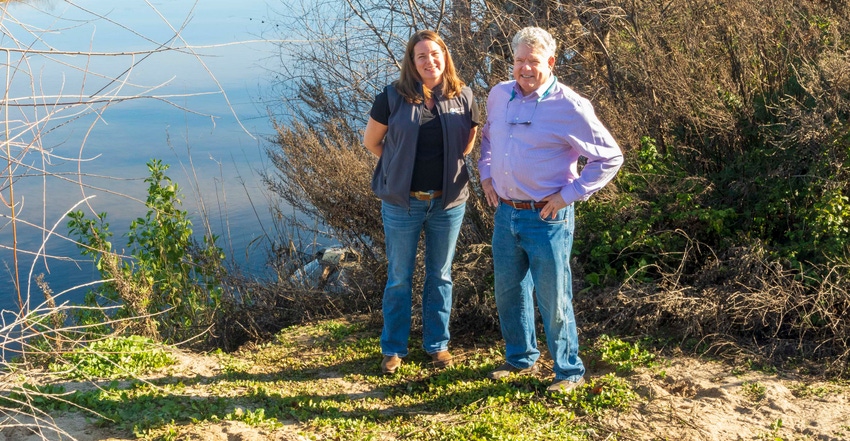
Restoring the population of an endangered rabbit is one on several collaborative conservation efforts on farmland at the confluence of two major California rivers.
The Dos Rios Ranch Preserve near Modesto is a visionary project developed in partnership between the non-profit conservation group River Partners and the Lyons family, owners of Mapes Ranch.
For decades the Lyons family managed Mapes Ranch and its Dos Rios property in part with wildlife in mind. A collaborative effort there decades ago led to the delisting of the Aleutian Cackling Goose from the Endangered Species List. Still, it was an active farming operation that produced tomatoes, corn, and forage crops, and grazed cattle.
"This used to be actively farmed and now they're rehabilitating the area," said Mapes Ranch owner Bill Lyons, Jr. of the preserve "It's really a good example of what can happen."
Public-private partnerships
About 10 years ago River Partners purchased 1,600 acres of farmland from Lyons that included eight miles of river frontage along the Tuolumne and San Joaquin rivers.
Since buying the property, River Partners embarked on the largest public-private floodplain restoration project in the state with an aim of habitat restoration. Though the region had long been farmed by the Lyons family, their conservation efforts, and partnerships to protect wildlife fit well with the River Partner's mission.
River Partners has an earned revenue financial model as part of its non-profit status, according to River Partners President Julie Rentner. They grow almonds on part of the property that in good years can help offset expenses incurred by restoration projects.
"We were founded by farmers who wanted to do habitat restoration," Renter said. Through that relationship, River Partners has learned farming techniques that are helping with riparian restoration.
In 2018 River Partners removed levees built by farmers to contain the Tuolumne and San Joaquin Rivers. Doing so opened about 1,000 acres of seasonally flooded lands used by wildlife, including the Riparian Brush Rabbit, an endangered species of considerable concern given it is thought to exist solely in the northern San Joaquin Valley's delta region and adjoining land. The flood plain restoration may also benefit declining salmon populations.
Rentner says the small rabbit is believed to be susceptible to a highly contagious virus called Rabbit Hemorrhagic Disease. The illness has a 90% mortality rate and could decimate the rabbit's population, once thought to number between 200 and 300. Collaborative efforts between wildlife agencies and River Partners are under way to get a more accurate count of the rabbit through trail cams. Work is also under way to trap and vaccinate the rabbits against the disease. Tracking collars are also being attached to the rabbits to better understand their movements.
"We talk about wildlife populations and resiliency, but through the scale that we could work on a property like this, we can actually see populations rebound," she said. "The bunnies are a good example. Where there's a new population, hundreds of rabbits now live out here that weren't here before, and that's a huge percentage of their population."
Armed with grant funds from private and public agencies, Rentner says the goal is to recreate the kind of riparian forest common to the area before farming practices changed how water flowed through the San Joaquin Valley. Included in this habitat restoration is the planting of trees that mimics orchard plantings with tighter row and tree spacings.
Removing the levees threatened non swimmers like the rabbit. Because of this, hills were created to rise above the historic flood levels to allow the rabbit and other animals a haven from high river flows.
In the spring months, Rentner says the area is flush with migrating songbirds that spend the Northern Hemisphere's winter period in Central and South America. Species such as the riparian woodrat, Swainson's hawk, least Bell's vireo, yellow warbler and sandhill crane benefit from the efforts. Chinook salmon, steelhead trout and white sturgeon have also been documented spawning near the restoration site.
Location
The Dos Rios project is legally outside of the river delta region, where regulatory constraints could hamper permits for restoration, Rentner says.
"The state has all these big goals and spends a lot of time and attention studying the Delta," she said. "We're just slightly out of that legal boundary, just a few miles upstream from the Delta, where the way the ecosystem functions is different, the science is a little bit different and the investment a bit different."
There is still much to learn about water, how it flows into and through the flood plains in this region of the state.
Under new groundwater rules that promise to reduce irrigated farmland acreage in California by as much as one million acres, Rentner sees some opportunities in land repurposing throughout the state, and the possibilities of creating beneficial uses for wildlife habitat on land that was once extensively farmed. These efforts could dovetail off of existing projects, like those at the Dos Rios Ranch Preserve.
"How do we find those locations where repurposing can be beneficial for a lot of other purposes too, like flood conveyance or wildlife habitat?" she asks.
About the Author(s)
You May Also Like






